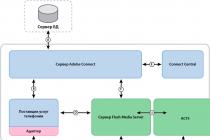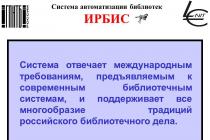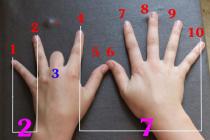Union of Soviet Socialist Republic of the Republic of Belarus independent Tue, certificates issued 23 L 111.1971689631126-25 p. 6 01 g 33/00 b 01 ъ 3/08 by the unification of the application-approval of the Committee of the Council of the Miyestrov SSS for inventions and discoveries Priority Publications 10,711.193, Bulletin 838 (088 that published writings 2 b.ХП.1 Author of the invention. G. Semevo Applicant ROSE MAGNETOMETER) The invention relates to a device for magnetic measurements and is designed to measure the parameters of the magnetic field with the issuance of information about them in digital form. The known magnetometer contains a ferromagnetic core with an input winding and a positive winding feedback, a broadband amplifier to the inputs of which these windings are connected, a digital frequency counter connected to the output of the broadband amplifier. Ferromagnetic core windings and a broadband amplifier form a self-oscillating generator.The oscillation frequency of the self-oscillator is determined by the inductance of the winding with a ferromagnetic core, which is a function of the permeability of the core, which, in turn, is a function of the external measured magnetic field strength. When the inductance increases under the action of the measured field, the oscillation frequency of the oscillator changes, and the measured magnetic field strength is judged from the readings of the frequency meter with a digital output. value), there is a displacement of the initial operating point within the hysteresis diagram B (which is, respectively, of the initial permeability of the core. This results in the measurement accuracy, since different readings of the frequency meter have the same value of the tension. The aim of the invention is to increase the inaccuracy and measurement of the magnetic field strength. is achieved by the fact that the magnetometer is equipped with an additional winding and a generator of unipolar pulses, to which an additional winding is connected, located on a ferromagnetic core, the diagram of the proposed magnetometer is shown in the drawing. The nitometer contains a ferromagnetic core 1 with windings: input 2, additional 20 and 3 and positive feedback winding 4; broadband amplifier 5, whose inputs are connected to windings 2 and 3; The ferromagnetic core 1 with the input winding 2 is part of the oscillatory circuit of the self-oscillating generator formed by the broadband amplifier 5 and oblique 393704 3 by the positive feedback winding 4. -1 The frequency of the self-oscillating generator is measured with a digital frequency meter. points along the additional winding 8 periodically pass unipolar pulses from the generator 7, creating a pulsed magnetic field strength exceeding the value of the technical saturation of the core 1. Due to the periodic magnetization of the core, the initial operating point is periodically dine at the same the initial state corresponding to the residual value of the magnetic induction along the limiting hysteresis loop of the core 1. 15 The repetition period of the pulses from the generator 7 exceeds the duration of the frequency counter b, so the action of the pulses does not affect the measurement result. Thus, the introduction of an additional winding 3 and a unipolar pulse generator 7, the output of which is connected to this winding, increases the accuracy of measuring the contamination of the magnetic field due to the stabilization of the initial operating point. The subject of the invention A fluxgate magnetometer containing a ferromagnetic core, an input winding, a feedback winding, a broadband amplifier and a frequency meter with a digital output, characterized in that, in order to improve the accuracy of measuring the magnetic field strength, a unipolar pulse generator is introduced into it with a connected output additional winding placed on a ferromagnetic core, Circulation 755 of the Committee of the Council of Ministers of the USSR L. Tsarkov and E. Blumin
Application
V. G. Semenov
IPC / Tags
Reference code
Fluxgate magnetometer
Similar patents
Designed for three channels. Indicating LEDs 17 in the number equal to the number of channels are placed on the light board. The device works as follows. When current flows through the stator winding at the output of the zener diode 4, there is a moment (bridge) 5, the output voltage of which is proportional to the deviation of those 30 40 45 50 "Inadmissible". 55 10 15 A series of half-wave pulses of a given value (determined by a zener diode 4), This voltage is applied to the temperature-sensitive measuring element of the insulation of the rod from a certain basic value. Level limiters, made, for example, in the form of thyristors 12-14, each set to a certain threshold turn-on voltage, Upon reaching a certain threshold, the limiter ...
Two measuring windings. connected in series-opposite. wound by the first layer closest to the core, the first of which is located on one yoke of the core, the second on the core rod, the measuring winding for measuring the voltage across the loads is located on the second, free, yoke, The set of features introduced in the limiting and distinctive aspects of the formula allows achieving the set goal. Among the known solutions, the indicated set of features is not found, but on the basis of which it can be concluded that the proposed device has significant differences, Fig. 1 shows an electrical diagram for implementing a method for measuring power. supplied to the loads of the transformer; in fig, 2 ...
The method is to simplify the measurement when reproducing the arrival of a unipolar wave along one phase of the high voltage winding of the transformer. This is achieved by disconnecting the generator under study from the low voltage winding of the transformer and bipolar pulses of opposite polarity are fed to two phases of the stator winding of the said generator, and the induced 25 voltage on the rotor winding of the generator. When an overvoltage wave is applied to both one and two phases of the high voltage winding of a transformer connected according to the scheme T, Mironov akaz 849.3TSNI Circulation 755 of the Council of Ministries and Otkrytyushskaya nab., 45 Izd. 406 state building cases of images Moscow, Zh, R Signature USSR AND G Printing house apunov, on the findings of two ...
To measure small constant and variable magnetic fields, flux gates are used, which are in the simplest form rods made of magnetically soft material and having two windings, one of which creates a temporary magnetic flux, and the other is a measuring one.
When passing through the excitation winding of an alternating current of a sinusoidal shape, the magnetic state of the core will change along a dynamic hysteresis loop, while an emulsion appears in the measuring winding. etc., which, in addition to the fundamental frequency, will contain the highest odd harmonics.

Rice. 21. Schematic diagram ballistic installation: electromagnet, measuring coil, ballistic galvanometer, primary and secondary windings of the reference coil, switches, key, rheostat system, A - ammeter

Rice. 22. Schematic arrangement of the measuring probe
If such a probe is placed in a constant magnetic field directed in the same way as the alternating field along the axis of the core, then the magnetic state of the core will already change in an asymmetric partial cycle. This is due to the fact that in the direction of the action of the constant field, the magnetization reversal of the core will occur at lower values of the alternating field than in the absence of the constant field, and in the opposite direction the constant field will prevent the magnetization reversal. In this case, in the e. etc. with. along with odd harmonics, even, mainly second, harmonics will appear. It turns out that the value of e. etc. with. this
harmonics are proportional to the magnetic field strength. The largest e. d. s. proportional to this harmonic, and measure the field strength.
In fig. 22 shows a schematic arrangement of one of the measuring probes, the core of which is made of the soft magnetic material permalloy. The core consists of 20-50 plates thick If the same number of turns of one wire is wound on both sides of the core in opposite directions, then the magnetic fluxes created by each winding will be equal.

Rice. 23. Schematic device of the bridge type magnetic probe

Rice. 24. To the device of the bridge probe
The windings are connected in series with each other. The measuring coil 3 is put on the core 1. If an alternating current is passed through the turns of the winding 2, then it will not occur in the measuring coil, since the changes in the magnetic flux in time from each winding 2 will be equal and opposite in direction. When the core is placed in a constant uniform field, which is directed perpendicular to the cross-sectional plane of the windings and the coil, a redistribution of magnetic fluxes in the space between the windings 2 will occur, since the constant field will add up with alternating fields, as a result of which an electromotive force will appear in the measuring coil 3. This e. etc. with. will be proportional to the strength of the magnetic field. With the help of such a probe at an alternating current frequency of 103 Hz, it is possible to measure magnetic fields of the order of
There are currently bridge-type magnetic probes. One of these bridges is shown in Fig. 23. The bridge is cut from a sheet of soft magnetic material (Fig. 24). Collect it from several sheets, one half of which is cut along, and the other - across the rolling. This ensures optimal magnetic uniformity of the bridge arms and improves the magnetic contact of the branches. The segments are folded over and connected to each other so that the second diagonal of the bridge is formed. Coils 1 and 2 are located on the diagonals of the bridge, and any of them can be either measuring or exciting. The winding of the field coil is powered by alternating current of industrial or
increased frequency. The magnetic bridge is in equilibrium, while without an external constant magnetic field, no emis- sion appears in the measuring coil. etc. with. If the bridge is placed in an external constant magnetic field, then the balance of the bridge is disturbed, an alternating magnetic flux will appear in the diagonal of the bridge, and emis- sion will appear in the measuring coil. etc. with. induction, the value of which determines the value of the external field strength. The maximum value of e. etc. with. arises in the measuring coil if the external field is directed parallel to two opposite branches of the bridge. To increase the sensitivity, a magnetic bridge is sometimes made with poles (Fig. 25).

Rice. 25. Schematic device of a magnetic probe with poles
Consider a highly sensitive compensation magnetometer for measuring the magnetic field strength before, where a magnetically saturated probe is used. The schematic diagram of the magnetometer and the section of the magnetically saturated probe are shown in Fig. 26 and 27.
The magnetometer circuit consists of an excitation and signal circuit, a compensation circuit and a circuit for testing the sensitivity of the device.
The excitation and signal circuit includes a generator 4, a frequency doubler 5, a phase discriminator 6, a resonant amplifier 7 and an indicator device 8. To increase the sensitivity, the device uses a compensation measurement method, in which the measured field of solenoid 2 is compensated by another field of a known value and in the opposite direction. This field is generated by a current coil, inside which a probe 1 is located. The compensation coil 3 is used either in the form of a conventional solenoid or in the form of a closed coil. The coil of the second type is used when ferromagnetic materials are located near the magnetometer.
Compensation can also be achieved by using a current that is passed through the measuring winding of the sample. At the same time, the dimensions of the measuring head are significantly reduced, but the homogeneity of the compensating field deteriorates. To supply the compensation circuit, use rechargeable batteries large capacity... The magnetically saturated probe consists of two cores 6 made of molybdenum permalloy. The cores are assembled from plates of size that are cut along the roll and heat-treated. On the cores there is an excitation winding 4, which has 1400 turns of wire with a diameter and a measuring winding 3 of 400 turns of wire
A voltage of 25 Hz is applied to the excitation winding. The excitation current is 0.3 A. Under these conditions, the installation has the highest sensitivity. Before starting measurements, the probe is tuned by moving the core in the Helmholtz coils. The signal received on the measuring winding is amplified by the tuned resonant amplifier, and then fed to the phase discriminator. The deviation of the arrow of the zero device by 2-3 divisions corresponds to the magnetic field strength. The described magnetometer is stable in operation and its mode practically does not depend on changes in external conditions (temperature, mechanical vibrations, etc.).

Rice. 26. Schematic diagram of a magnetometer with a magnetic probe: 1 - probe, 2 - solenoid, 3 - compensating coil, 4 - generator, 5 - frequency doubler, 6 - phase discriminator, 7 - resonance amplifier, 8 - indicator device, compensation circuit, circuit to test the sensitivity of the device
The work shows the calculation of the optimal operating conditions of the probe, consisting of two permalloy cores with dimensions 0.18X1.75X100 The excitation winding is wound from a wire with a length of 350 turns, The measuring winding consists of 1500 turns of wire. weekend e. etc. with. second harmonic. The following formula is used to calculate the effective value of the amplitude of this harmonic:
where is the external measured magnetic field, the sensitivity of the probe to the external field in the second harmonic. The last value is determined by the formula
where the number of turns of the measuring winding, the cross-sectional area of the cores, is the frequency of the alternating current supplying the excitation winding, the coefficient taking into account the dissipation of the flux is some constant depending on the magnetic properties of the material and the demagnetizing factor.
The sensitivity is determined at the optimal value of the bias current, the strength of which is calculated by the formula
![]()
where is the number of turns in the excitation winding.
The described probe has high sensitivity if a long core is used.
Grabowski and Skorobogatov used a permalloy flux gate to measure the coercive force.Their installation consisted of two completely identical magnetizing coils, between which a flux probe was located with a length of width and thickness. To measure the coercive force, a magnetized sample was placed in one of the coils, while the magnetic field of the sample caused a deflection of the instrument needle, which was connected to an indicator winding located on the flux gate. Passing a direct current through the magnetizing coils, the sample was gradually demagnetized. At the moment when the arrow of the indicator device returned to zero position, the current in the coils was measured and the value of the coercive force was calculated using the formula where is the constant of the coil.
Rice. 27. (see scan) Sectional view of the magnetic probe: 1 - current-carrying petals, 2 - housing, 3 - measuring winding, 4 - excitation winding, 5 - frame, 6 - core, 7 - insulating gasket
With the described coercimeter, you can quickly measure with an accuracy of 2-3%.
In the Janus coercimeter, the flux gate has the shape of a frame, on the sides of which there are two windings: excitation and measuring. The test sample is placed in the solenoid so that its ends protrude from the solenoid. They are adjacent to an iron yoke, the middle part of which is closed by a flux gate core.
Drozhzhina and Friedman proposed a flux-gate
magnetometer for studying the magnetic properties of soft magnetic materials. In their magnetometer, the moving astatic system was replaced by flux gates, which made it possible to eliminate zero oscillations. The flux gate consists of two cores made of permalloy. The field windings are connected in series so that the magnetic fluxes of the cores are mutually closed. The measuring windings of the fluxgate are switched on differentially, and without an external constant field, the sum of the induced emf. etc. with. in these windings is zero. In the presence of a constant magnetic field in e. etc. with. even harmonics appear, the magnitude of which determines this field.
The fluxgate magnetometer consists of two identical solenoids, located horizontally one below the other, into one of which the sample under study is placed. The differential flux gate is located between these solenoids. The magnetic fields of solenoids without a sample are mutually compensated in the volume where the flux gate is located.
For high-quality measurements, it is better to use an astatic fluxgate magnetometer. In this version, one flux gate is located between the solenoids, and the other is at a distance from the first in a parallel horizontal plane. The windings of these flux gates are connected in series towards each other.
A fluxgate magnetometer can be used to determine the magnetization curve, hysteresis loop and coercive force of soft magnetic materials. The magnetization curve and the hysteresis loop are measured by the compensation method. For this purpose, a current is passed through the compensating winding, the magnetic field of which compensates for the field of the magnetized sample in the vicinity of the probe. To measure the coercive force, you need to magnetize the sample, and then, by increasing the demagnetizing field, bring the readings of the indicator device to zero. Simple circuit and a fast measurement process are one of the advantages of a fluxgate magnetometer over other magnetometers, which will be described in chapter V. B recent times some types of magnetic probes began to be used to study the magnetic field in accelerators and spectrometers. The description of the probes is also available in the papers.
The electromagnetic phenomena in a transformer with a steel core are similar to those in an air transformer, but the magnetic flux that permeates both windings is not closed through the air, but through the steel core (Figure 15.31).
When the transformer is loaded, there are three magnetic fluxes: F- the main one in the core, F σ 1 - scattering associated only with the primary winding, F σ 2 - scattering associated only with the secondary winding.
The main magnetic flux induces an emf in the primary and secondary windings. respectively e 1 and e 2. Magnetic flux scattering F σ 1 and F σ 2 is induced in the primary and secondary windings of the emf. respectively e σ 1 and e σ 1 .
Voltage u 1 , applied to the primary winding is balanced by the voltage drop across the active resistance of the winding and electromotive forces e σ 1 and e σ 1, i.e.
Consider first an ideal transformer in which r 1 = 0; x σ 1 = 0; r 2 = 0; x σ 2 = 0; w 1 = w 2 .
At idle, such a transformer does not differ from a conventional ideal coil and can be depicted by an equivalent circuit (Figure 15.33).







r m


Let's build a vector diagram of an ideal transformer at no-load (Figure 15.34).

No-load magnetizing force
Let us now draw up an equivalent circuit for an ideal transformer under its load (Fig. 15.35).
If a load with resistance is connected to the terminals of the secondary winding Z n, then a current will pass in it  , which, in turn, will tend to reduce the magnetic flux
, which, in turn, will tend to reduce the magnetic flux  , and this will lead to a decrease in the emf.
, and this will lead to a decrease in the emf.  ,
whereby the current
,
whereby the current  will increase
to such a value at which the magnetic flux
will increase
to such a value at which the magnetic flux  will acquire its original value and the equation (15.35) will be fulfilled.
will acquire its original value and the equation (15.35) will be fulfilled.

Thus, the appearance of a current in the secondary circuit leads to an increase in the current in the primary circuit. In a loaded transformer, the magnetic flux in the core is equal to the magnetic flux at no-load, i.e. always F= const. When loaded, the magnetic flux  created under the action of the magnetizing forces of the primary and secondary windings:
created under the action of the magnetizing forces of the primary and secondary windings:
|
|
Let's build a vector diagram of an ideal transformer under load (Figure 15.36).

We will transform the equivalent circuit of an ideal transformer, for which we will get rid of inductive coupling. If you connect the terminals of the same name of the transformer windings with each other, then the operating mode of the transformer will not change.
Consider first inductively coupled elements that now have a common point. The coupling coefficient of the two elements in this case is equal to unity, since the entire magnetic flux is completely coupled with the turns of the primary and secondary windings, i.e.
|
|
therefore, given that w 1 = w 2, we find:
|
|
We will now replace part of the circuit with inductively coupled elements with a common point (Fig. 15.37 a) to an equivalent circuit without inductive coupling (Fig. 15.37 b).

 ;
;
 ;
;
Taking into account the found, the circuit takes the form shown in Fig. 15.37 v, and the equivalent circuit of an ideal transformer is the view shown in Fig. 15.38.
If we now take into account the active and inductive leakage resistances of both windings, then for a transformer with w 1 = w 2, we get the equivalent circuit shown in Fig. 15.39.


Let's write down the equations of the primary and secondary circuits of the circuit:
|
| |
Let's build a vector diagram of the circuit (Figure 15.40).
In magnetometers of this type, a magnetically sensitive element is a flux gate, which is two thin and long permalloy rods (iron-nickel alloy - soft magnetic ferromagnet), on which the primary (exciting) winding is wound in a reciprocal direction. In addition, both cores, together with the primary winding, are covered by the secondary (measuring) winding (Figure 3.15 a). Soft magnetic ferromagnets are characterized by the fact that the hysteresis loop for them is so narrow that it can be considered as one curve (Fig. 3.15 b).
Rice. 3.15. The principle of operation of a fluxgate magnetometer
second harmonic type.
The principle of operation of the flux gate is as follows. By using external source current with frequency w (most often 400 Hz) is passed through the primary (exciting) winding. If there is no external magnetic field, then the initial magnetization of the cores is zero. When a current is passed with a frequency of w in each half-period, the induction pulses in the cores are directed oppositely and compensate each other (Figure 3.15 b). Therefore, the total induction in the space closest to the cores at each moment of time is equal to zero and the signal is not induced in the measuring winding, i.e. is also zero.
When an external field T appears (which must be measured) in each half-period, this field coincides with the induction of one of the cores, and the induction of the other core is directed in the opposite direction, which is equivalent to a shift in the induction of the cores. The total (total B S) induction in space at the cores, adding up, forms an alternating magnetic flux, changing with a frequency of 2w (Figure 3.15. B). This flux induces in the measuring winding an electrical signal with a frequency of 2w and an amplitude proportional to the "shift" of the induction in the windings - the external magnetizing field T.
To measure this field, it is only necessary to select with a filter (Ф) a signal with a frequency of 2w (800 Hz), amplify it with an amplifier (Y), determine the sign of the field (phase) with a phase-sensitive detector (PSD) and measure its amplitude with a meter (I). In this case, the device measuring the signal amplitude can be graduated in units of the strength or induction of the magnetic field. Such a flux gate is called a second harmonic flux gate.
A useful feature of such a flux gate for magnetic surveys is that it can measure the component of the magnetic field strength directed along the axis of the probe. That is, if the field T is directed perpendicular to the cores, then there will be no "shift" of induction in the windings and there will be no signal in the secondary winding.
This feature makes it possible to carry out the so-called component measurements (i.e., measurements of the three components along the axes) of the magnetic induction, which is one of the advantages of the method. The disadvantage of this method is the presence of a zero bias of the device, which, even with a high sensitivity threshold of the device of 1 nT, does not allow measurements with high accuracy.
Ferro probe also has other names: magnetic saturation probe, magnetomodulation sensor (MMD). In foreign literature, it is called flux - date (flux gate) - flux-passing.

 .
. ,
, .
. ;
;












